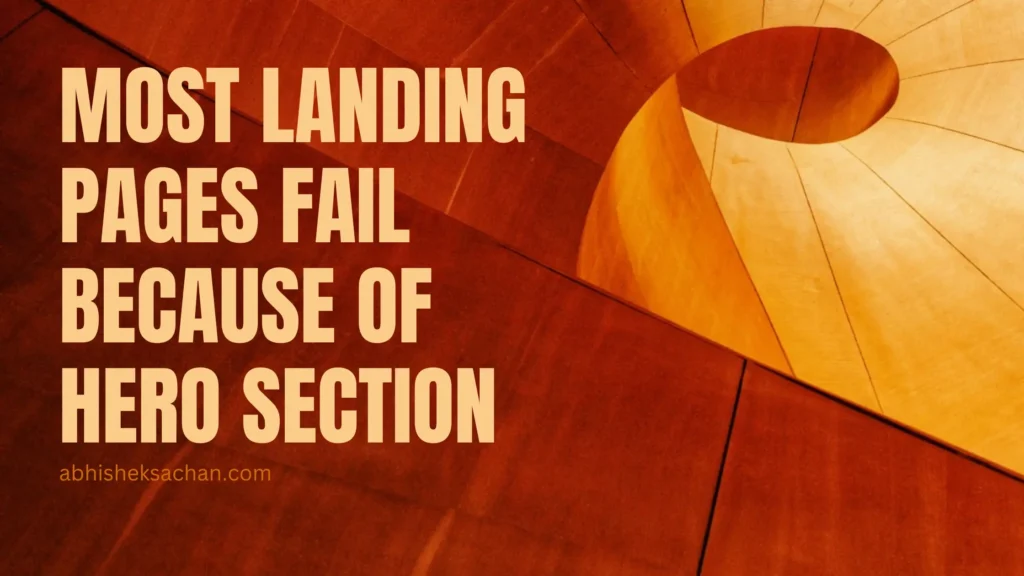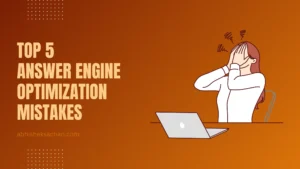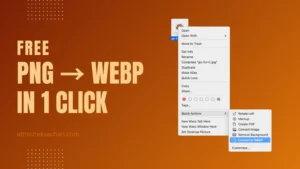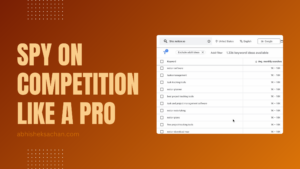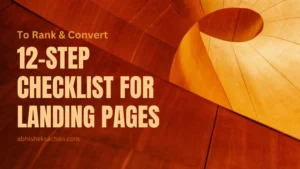Last week, I reviewed more than 10 landing pages who contacted through Landing Pages Roast(Feedback) Service I offer. These were from early-stage startups, established SaaS tools, and everything in between. Despite the variety, one issue was most common i.e. the hero section messaging.
It’s surprising how often this part is overlooked. The hero section is literally the first thing someone sees when they land on your page. It’s your one shot to grab attention, communicate value, and convince someone to stick around. Yet, so many get it wrong, and in doing so, they lose conversions before the page even gets a chance to load fully.
I won’t be able to give you exact pages due to privacy clause I have with my clients, but I can share my observations in general.
Where Most Go Wrong: The Hero Section
A lot of these landing pages opened with headlines that felt vague or too high-level. Things like “Innovating the future of work” or “Simplifying life for modern teams.” They sound nice, but they don’t say much. When I read them, I found myself asking: “What do you actually do?” And if I’m asking that, chances are a first-time visitor is too.
The problem is simple: people use their hero section to sound impressive instead of using it to connect. But the goal isn’t to win an award for clever phrasing. It’s to make the visitor feel like they’ve landed in the right place.
Another issue is assuming users will scroll to understand more. Many won’t. If your top section doesn’t engage them, they won’t even give the rest of your page a shot.
Hero Section Copy
The most effective hero sections I’ve seen and the few from my review that did it well addressed a clear problem or pain point right away.
Let’s say you’re selling a tool that simplifies bookkeeping for freelancers. A weak hero headline might be:
“Reimagining Finances for the Future”
A stronger alternative would be:
“Stop Dreading Tax Season. Track Income and Expenses in Minutes.”
That version speaks directly to a freelancer’s pain point. It hints at ease, speed, and relevance. No room for misinterpretation.
From my review, I noticed a clear trend: pages that nailed the hero copy also kept me engaged longer. I scrolled. I clicked. The ones that didn’t? Took me longer to figure out what the business do, in order to provide feedback.
Microcopy and CTAs
The hero section isn’t just about the headline and subhead. The little bits of text around your call-to-action (CTA) matter a lot. I saw several pages where the CTA button just said “Download” or “Book a Call” That’s not helpful. If you’re offering a free trial, say “Start Free Trial.” If you’re booking a demo, say “Book Free Demo.” Give people a reason to click.
What’s missing most often is supportive microcopy. A small line like “No credit card required” or “Takes less than a minute” can remove doubt. These aren’t just fluff, they’re friction removers. And when done right, they can make your CTA way more effective.
These small details create clarity and build trust. And trust is what moves a user’s cursor to click.
Trust Factors
Another thing I kept looking for in those pages? Trust signals. Client logos, a short testimonial, a badge, anything that says “Others have tried this and it worked.” But on most pages, this was either buried way below the fold or missing altogether.
Putting a line like “Trusted by 1,200+ teams” or showing a recognizable brand’s logo in the hero section isn’t about bragging. It’s about helping someone feel safe taking the next step.
You don’t need to overload this section with everything you’ve got. Just enough to signal, “Hey, others have trusted us, and it worked.”
Set the Stage to Scroll Landing Page
The hero section sets the stage for everything that follows. If it’s strong, people are more likely to scroll down, explore features, read testimonials, and eventually convert. If it’s weak or confusing, they won’t bother. During my review, I could tell within seconds which pages had a chance and which didn’t just based on the hero section.
It’s not just about design either. Some beautifully designed pages still missed the mark because their messaging didn’t speak to the user. The tone didn’t match the audience, or the problem wasn’t clearly defined.
When the Hero Section Converts on Its Own
One of the landing pages I reviewed had such a sharp, well-crafted hero section that I didn’t need to scroll. It told me what the product was, who it was for, what problem it solved, and had a solid CTA. That’s rare, but it’s powerful when done right.
If your product has a clear value proposition and solves a specific problem, there’s no reason your hero section can’t drive conversions on its own. You just have to put in the work to make it that clear and compelling.
So here’s the thing: if you’re building or optimizing a landing page, don’t treat the hero section like just another box to fill. It’s not just decoration. It’s your first impression and sometimes your only chance.
After reviewing over a dozen landing pages last week, I can say with confidence — get your hero section right, and the rest of your page gets a real shot at working. Get it wrong, and no amount of scroll-triggered animations or testimonials will save it.
If you need my help in reviewing your landing page, fill the form I’ll be happy to help(It’s Free).
